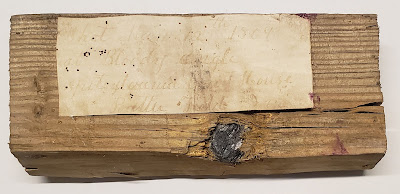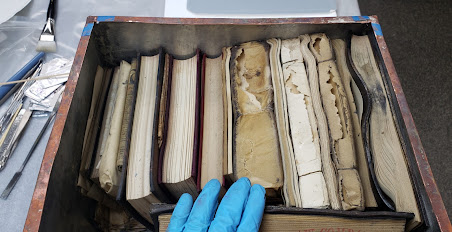 |
| Two minie balls found in cornerstone box (Virginia Department of Historic Resources photos) |
 |
| Piece of wood from the Bloody Angle at Spotsylvania with minie ball |
An
interesting assertion appeared last week in a Virginia Department of Historic
Resources (DHR) update about the project, which included an inventory of the box's contents. The article challenges media descriptions of the 36-pound
copper box as a time capsule.
William Bryan Isaacs, a leading Freemason living in Virginia,
oversaw the placement of the box. The article asks whether he and others meant
for the box to be opened by a later generation, as is the case with time capsules.
“Isaacs and his contemporaries would not have thought so. Not
only was the term not used widely until the 1930s, but cornerstone boxes were
inherently foundational,” the update says. “The items inside were meant for 'a
far remote posterity' and were not intended to be readily accessed and explored
on a certain date in the future."
 |
| Despite some moisture, contents were in good shape (Virginia Department of Historic Resources) |
It’s important to note the contents of the box did not highlight the contributions of many in the community. Local historian and author Dale Brumfield told ABC News, “What was not in it was anything relating to the Black community of Richmond. Richmond had a thriving Black middle class at the time ... and there was nothing pertaining to that."
 |
| "Gray and blue badge" and a muster roll of 21st Virginia (VDHR) |
One more note before additional photographs below. The discovery of this box was not a surprise, given the newspaper article at the time detailing donations from area citizens. A box found shortly before in the statue pedestal was. It turned out to be items experts believe were placed by the monument's builders.
The inventory lists a Frank Brown as the donor of the piece of wood (top photo) from the Bloody Angle at Spotsylvania, dated May 12, 1864. It includes a shattered Minie ball and a piece of paper describing the location.
Brown also donated Minie balls described as coming from the Battle of Fredericksburg. The box included five bullets, with the 1887 inventory indicating Brown gave three. But which three belonged to Brown, and were all five from Fredericksburg, asks Ridgway and others.
 |
| Additional Minie balls, with two indicating impact (Virginia Department of Historic Resources) |
The Virginia Confederate button below is associated with Capt. Cyrus Bossieux, who, according to findagrave, enlisted in 1861 and served with the 1st Virginia Regiment (Company A, in which he served, was known as the Richmond Grays) and the 3rd Virginia Artillery.
Bossieux, interestingly, is in a famous photograph of the Richmond Grays at the execution of abolitionist John Brown before the Civil War. It is in the collection of the Library of Congress.
 |
| Bossieux button (Virginia Department of Historic Resources) |
Goodreads.com provides this summary of the volume: “This Civil War classic of soldiering in the ranks debunks all the romantic notions of war. Like his Northern counterpart, the Confederate soldier fought against bullets, starvation, miserable weather, disease, and mental strain. But the experience was perhaps even worse for Johnny Reb because of the odds against him."
DHR, in its article last week, said it will post future articles on the two boxes found in the Lee pedestal. They will be published on Wednesdays.
"We have asked experts from across the Commonwealth to choose artifacts and tell us more about them," the agency said. "We are so lucky that the artifacts were in such good condition and that Virginia has such fantastic experts to call upon to help us create articles that keep those who live in the Commonwealth and further abroad informed."
 |
| (Virginia Department of Historic Resources) |
At right, is a fragment of an iron shell purportedly fired at the Battle of Fredericksburg in 1862 and listed in the 1887 inventory as being donated by Frank Brown.
Ridgway says there are some questions about a rock described as being a piece of a stone wall at Fredericksburg, also donated by Brown.
"In the box was found a smooth stone, an aggregate of small stones, and a piece of what might be mortar. Are one or all of these the 'piece of a stone wall' mentioned in 1887? Some of these answers will take time and research," the DHR article says.
 |
| Rock found in box (Virginia Department of Historic Resources) |
"The whole thing has been kind of a whirlwind. While I was expecting the cornerstone box to be found, no one knew exactly when that would happen," Ridgway told the Picket this week in an email.
"Once they found it, there was a lot of work to do and the time
flew by. I was working with such a great team of professionals from UVA,
Colonial Williamsburg, and the VMFA (Virginia Museum of Fine Arts) that the process went very smoothly, even
with all of the cameras and reporters. Now it is exciting to have curators and
historians from around the Commonwealth coming to see the artifacts and help
us understand the contents of the containers."
 |
| Recovered box before it was opened (Virginia Department of Historic Resources) |


No comments:
Post a Comment